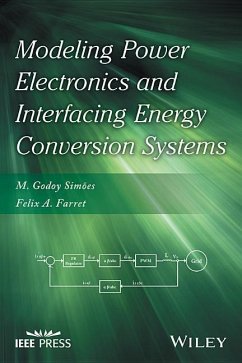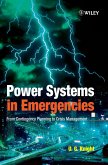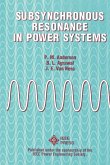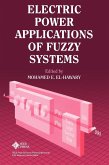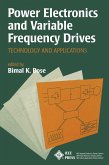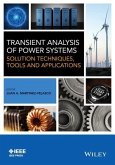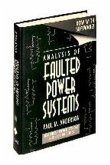- Gebundenes Buch
- Merkliste
- Auf die Merkliste
- Bewerten Bewerten
- Teilen
- Produkt teilen
- Produkterinnerung
- Produkterinnerung
Discusses the application of mathematical and engineering tools for modeling, simulation and control oriented for energy systems, power electronics and renewable energy This book builds on the background knowledge of electrical circuits, control of dc/dc converters and inverters, energy conversion and power electronics. The book shows readers how to apply computational methods for multi-domain simulation of energy systems and power electronics engineering problems. Each chapter has a brief introduction on the theoretical background, a description of the problems to be solved, and objectives to…mehr
Andere Kunden interessierten sich auch für
![Power Systems in Emergencies Power Systems in Emergencies]() U G KnightPower Systems in Emergencies281,99 €
U G KnightPower Systems in Emergencies281,99 €![Subsynchronous Resonance in Power Systems Subsynchronous Resonance in Power Systems]() Paul M AndersonSubsynchronous Resonance in Power Systems180,99 €
Paul M AndersonSubsynchronous Resonance in Power Systems180,99 €![Electric Power Applications of Fuzzy Systems Electric Power Applications of Fuzzy Systems]() Electric Power Applications of Fuzzy Systems246,99 €
Electric Power Applications of Fuzzy Systems246,99 €![Power Electronics and Variable Frequency Drives Power Electronics and Variable Frequency Drives]() Power Electronics and Variable Frequency Drives259,99 €
Power Electronics and Variable Frequency Drives259,99 €![Transient Stability of Power Systems Transient Stability of Power Systems]() M. PavellaTransient Stability of Power Systems676,99 €
M. PavellaTransient Stability of Power Systems676,99 €![Transient Analysis of Power Systems Transient Analysis of Power Systems]() Transient Analysis of Power Systems183,99 €
Transient Analysis of Power Systems183,99 €![Analysis of Faulted Power Systems Analysis of Faulted Power Systems]() Paul M AndersonAnalysis of Faulted Power Systems225,99 €
Paul M AndersonAnalysis of Faulted Power Systems225,99 €-
-
-
Discusses the application of mathematical and engineering tools for modeling, simulation and control oriented for energy systems, power electronics and renewable energy This book builds on the background knowledge of electrical circuits, control of dc/dc converters and inverters, energy conversion and power electronics. The book shows readers how to apply computational methods for multi-domain simulation of energy systems and power electronics engineering problems. Each chapter has a brief introduction on the theoretical background, a description of the problems to be solved, and objectives to be achieved. Block diagrams, electrical circuits, mathematical analysis or computer code are covered. Each chapter concludes with discussions on what should be learned, suggestions for further studies and even some experimental work. * Discusses the mathematical formulation of system equations for energy systems and power electronics aiming state-space and circuit oriented simulations * Studies the interactions between MATLAB and Simulink models and functions with real-world implementation using microprocessors and microcontrollers * Presents numerical integration techniques, transfer-function modeling, harmonic analysis and power quality performance assessment * Examines existing software such as, MATLAB/Simulink, Power Systems Toolbox and PSIM to simulate power electronic circuits including the use of renewable energy sources such as wind and solar sources Modeling Power Electronics and Interfacing Energy Conversion Systems serves as a reference for undergraduate and graduate students studying electrical engineering as well as practicing engineers interested in power electronics, power systems, power quality and alternative or renewable energy.
Hinweis: Dieser Artikel kann nur an eine deutsche Lieferadresse ausgeliefert werden.
Hinweis: Dieser Artikel kann nur an eine deutsche Lieferadresse ausgeliefert werden.
Produktdetails
- Produktdetails
- Verlag: Wiley
- Seitenzahl: 352
- Erscheinungstermin: 24. Oktober 2016
- Englisch
- Abmessung: 236mm x 157mm x 23mm
- Gewicht: 612g
- ISBN-13: 9781119058267
- ISBN-10: 1119058260
- Artikelnr.: 44679040
- Herstellerkennzeichnung
- Libri GmbH
- Europaallee 1
- 36244 Bad Hersfeld
- gpsr@libri.de
- Verlag: Wiley
- Seitenzahl: 352
- Erscheinungstermin: 24. Oktober 2016
- Englisch
- Abmessung: 236mm x 157mm x 23mm
- Gewicht: 612g
- ISBN-13: 9781119058267
- ISBN-10: 1119058260
- Artikelnr.: 44679040
- Herstellerkennzeichnung
- Libri GmbH
- Europaallee 1
- 36244 Bad Hersfeld
- gpsr@libri.de
Marcelo Godoy Simões is the director of the Center for Advanced Control of Energy and Power Systems (ACEPS) at Colorado School of Mines. He was an US Fulbright Fellow for Aalborg University, Institute of Energy Technology (Denmark). He is IEEE Fellow, with the citation: "for applications of artificial intelligence in control of power electronics systems." Dr. Simões is a pioneer to apply neural networks and fuzzy logic in power electronics, motor drives and renewable energy systems. He is co-author of the book Integration of Alternative Sources of Energy (Wiley 2006), now in the second edition. Felix A. Farret is co-author of the book Integration of Alternative Sources of Energy (Wiley 2006, now in the second edition). Currently he is a Professor in the Department of Processing Energy, Federal University of Santa Maria, Brazil. Since 1974, he has taught undergraduate and graduate courses and has been conducting research and development in industrial electronics and alternative energy sources.
Foreword xi
Preface xiii
1 Introduction to Electrical Engineering Simulation 1
1.1 Fundamentals of State-Space-Based Modeling 4
1.2 Example of Modeling an Electrical Network 6
1.3 Transfer Function 9
1.3.1 State Space to Transfer Function Conversion 10
1.4 Modeling and Simulation of Energy Systems and Power Electronics 12
1.5 Suggested Problems 18
Further Reading 25
2 Analysis of Electrical Circuits with Mesh and Nodal Analysis 27
2.1 Introduction 27
2.2 Solution of Matrix Equations 28
2.3 Laboratory Project : Mesh and Nodal Analysis of Electrical Circuits
with Superposition Theorem 29
2.4 Suggested Problems 37
References 40
Further Reading 40
3 Modeling and Analysis of Electrical Circuits with Block Diagrams 43
3.1 Introduction 43
3.2 Laboratory Project: Transient Response Study and Laplace
Transform-Based Analysis Block Diagram Simulation 45
3.3 Comparison with Phasor-Based Steady-State Analysis 52
3.4 Finding the Equivalent Thèvenin 54
3.5 Suggested Problems 56
Further Reading 58
4 Power Electronics: Electrical Circuit-Oriented Simulation 61
4.1 Introduction 61
4.2 Case Study: Half-Wave Rectifier 67
4.3 Laboratory Project: Electrical Circuit Simulation Using PSIM and
Simscape Power Systems MATLAB Analysis 72
4.4 Suggested Problems 79
Further Reading 81
5 Designing Power Electronic Control Systems 83
5.1 Introduction 83
5.1.1 Control System Design 85
5.1.2 Proportional-Integral Closed-Loop Control 86
5.2 Laboratory Project: Design of a DC/DC Boost Converter Control 89
5.2.1 Ideal Boost Converter 89
5.2.2 Small Signal Model and Deriving the Transfer Function of Boost
Converter 90
5.2.3 Control Block Diagram and Transfer Function 93
5.3 Design of a Type III Compensated Error Amplifier 95
5.3.1 K Method 95
5.3.2 Poles and Zeros Placement in the Type III Amplifier 96
5.4 Controller Design 97
5.5 PSIM Simulation Studies for the DC/DC Boost Converter 99
5.6 Boost Converter: Average Model 99
5.7 Full Circuit for the DC/DC Boost Converter 103
5.8 Laboratory Project: Design of a Discrete Control in MATLAB Corunning
with a DC Motor Model in Simulink 107
5.9 Suggested Problems 112
References 116
Further Reading 116
6 Instrumentation and Control Interfaces for Energy Systems and Power
Electronics 117
6.1 Introduction 117
6.1.1 Sensors and Transducers for Power Systems Data Acquisition 118
6.2 Passive Electrical Sensors 119
6.2.1 Resistive Sensors 119
6.2.2 Capacitive Sensors 121
6.2.3 Inductive Sensors 123
6.3 Electronic Interface for Computational Data in Power Systems and
Instrumentation 125
6.3.1 O perational Amplifiers 125
6.4 Analog Amplifiers for Data Acquisition and Power System Driving 125
6.4.1 Level Detector or Comparator 126
6.4.2 Standard Differential Amplifier for Instrumentation and Control 127
6.4.3 O ptically Isolated Amplifier 128
6.4.4 The V-I Converter of a Single Input and Floating Load 130
6.4.5 Schmitt Trigger Comparator 131
6.4.6 Voltage-Controlled Oscillator (VCO) 131
6.4.7 Phase Shifting 131
6.4.8 Precision Diode, Precision Rectifier, and the Absolute Value
Amplifier 134
6.4.9 High-Gain Amplifier with Low-Value Resistors 136
6.4.10 Class B Feedback Push-Pull Amplifiers 137
6.4.11 Triangular Waveform Generator 137
6.4.12 Sinusoidal Pulse Width Modulation (PWM) 138
6.5 Laboratory Project: Design a PWM Controller with Error Amplifier 140
6.6 Suggested Problems 140
References 145
7 Modeling Electrical Machines 147
7.1 Introduction to Modeling Electrical Machines 147
7.2 Equivalent Circuit of a Linear Induction Machine Connected to the
Network 148
7.3 PSIM Block of a Linear IM Connected to the Distribution Network 150
7.4 PSIM Saturated IM Model Connected to the Distribution Network 152
7.5 Doubly Fed Induction Machine Connected to the Distribution Network 154
7.6 DC Motor Powering the Shaft of a Self-Excited Induction Generator 156
7.7 Modeling a Permanent Magnet Synchronous Machine (PMSM) 158
7.8 Modeling a Saturated Transformer 158
7.9 Laboratory Project: Transient Response of a Single-Phase Nonideal
Transformer for Three Types of Power Supply-Sinusoidal, Square Wave, and
SPWM 158
7.10 Suggested Problems 169
References 175
Further Reading 175
8 Stand-Alone and Grid-Connected Inverters 177
8.1 Introduction 177
8.2 Constant Current Control 181
8.3 Constant P-Q Control 182
8.4 Constant P-V Control 183
8.5 IEEE 1547 and Associated Controls 184
8.6 P+Resonant Stationary Frame Control 187
8.7 Phase-Locked Loop (PLL) for Grid Synchronization 188
8.8 Laboratory Project: Simulation of a Grid-Connected/Stand-Alone Inverter
190
8.9 Suggested Problems 197
References 199
Further Reading 201
9 Modeling Alternative Sources of Energy 203
9.1 Electrical Modeling of Alternative Power Plants 203
9.2 Modeling a Photovoltaic Power Plant 204
9.3 Modeling an Induction Generator (IG) 205
9.4 Modeling a SEIG Wind Power Plant 207
9.5 Modeling a DFIG Wind Power Plant 208
9.6 Modeling a PMSG Wind Power Plant 208
9.7 Modeling a Fuel Cell Stack 211
9.8 Modeling a Lead Acid Battery Bank 215
9.9 Modeling an Integrated Power Plant 219
9.10 Suggested Problems 224
References 225
10 Power Quality Analysis 227
10.1 Introduction 227
10.2 Fourier Series 231
10.3 Discrete Fourier Transform for Harmonic Evaluation of Electrical
Signals 237
10.3.1 Practical Implementation Issues of DFT Using FFT 237
10.4 Electrical Power and Power Factor Computation for Distorted Conditions
239
10.5 Laboratory Project: Design of a DFT-Based Electrical Power Evaluation
Function in MATLAB 242
10.6 Suggested Problems 250
References 253
Further Reading 253
11 From PSIM Simulation to Hardware Implementation in DSP 255
Hua Jin
11.1 Introduction 255
11.2 PSIM Overview 255
11.3 From Analog Control to Digital Control 257
11.4 Automatic Code Generation in PSIM 264
11.4.1 TI F28335 DSP Peripheral Blocks 265
11.4.2 Adding DSP Peripheral Blocks 266
11.4.3 Defining SCI Blocks for Real-Time Monitoring and Debugging 271
11.5 PIL Simulation with PSIM 272
11.6 Conclusion 275
References 278
Further Reading 278
12 Digital Processing Techniques applied to Power Electronics 279
Danilo Iglesias Brandão and Fernando Pinhabel Marafão
12.1 Introduction 279
12.2 Basic Digital Processing Techniques 280
12.2.1 Instantaneous and Discrete Signal Calculations 280
12.2.2 Derivative and Integral Value Calculation 280
12.2.3 Moving Average Filter 282
12.2.4 Laboratory Project: Active Current Calculation 286
12.3 Fundamental Component Identification 287
12.3.1 IIR Filter 288
12.3.2 FIR Filter 290
12.3.3 Laboratory Project: THD Calculation 291
12.4 Fortescue's Sequence Components Identification 293
12.4.1 Sequence Component Identification Using IIR Filter 296
12.4.2 Sequence Component Identification Using DCT Filter 297
12.4.3 Laboratory Project: Calculation of Negative- and Zero-Sequence
Factors 298
12.5 Natural Reference Frame PLLs 300
12.5.1 Single-Phase PLL 301
12.5.2 Three-Phase PLL 302
12.5.3 Laboratory Project: Single-Phase PLL Implementation 303
12.5.4 Laboratory Project: Fundamental Wave Detector Based on PLL 306
12.6 MPPT Techniques 307
12.6.1 Perturb and Observe 310
12.6.2 Incremental Conductance 310
12.6.3 Beta Technique 312
12.6.4 Laboratory Project: Implementing the IC Technique 312
12.7 Islanding Detection 314
12.7.1 Laboratory Project: Passive Islanding Detection Based on IEEE Std.
1547 315
12.8 Suggested Problems 317
References 319
Index 321
Preface xiii
1 Introduction to Electrical Engineering Simulation 1
1.1 Fundamentals of State-Space-Based Modeling 4
1.2 Example of Modeling an Electrical Network 6
1.3 Transfer Function 9
1.3.1 State Space to Transfer Function Conversion 10
1.4 Modeling and Simulation of Energy Systems and Power Electronics 12
1.5 Suggested Problems 18
Further Reading 25
2 Analysis of Electrical Circuits with Mesh and Nodal Analysis 27
2.1 Introduction 27
2.2 Solution of Matrix Equations 28
2.3 Laboratory Project : Mesh and Nodal Analysis of Electrical Circuits
with Superposition Theorem 29
2.4 Suggested Problems 37
References 40
Further Reading 40
3 Modeling and Analysis of Electrical Circuits with Block Diagrams 43
3.1 Introduction 43
3.2 Laboratory Project: Transient Response Study and Laplace
Transform-Based Analysis Block Diagram Simulation 45
3.3 Comparison with Phasor-Based Steady-State Analysis 52
3.4 Finding the Equivalent Thèvenin 54
3.5 Suggested Problems 56
Further Reading 58
4 Power Electronics: Electrical Circuit-Oriented Simulation 61
4.1 Introduction 61
4.2 Case Study: Half-Wave Rectifier 67
4.3 Laboratory Project: Electrical Circuit Simulation Using PSIM and
Simscape Power Systems MATLAB Analysis 72
4.4 Suggested Problems 79
Further Reading 81
5 Designing Power Electronic Control Systems 83
5.1 Introduction 83
5.1.1 Control System Design 85
5.1.2 Proportional-Integral Closed-Loop Control 86
5.2 Laboratory Project: Design of a DC/DC Boost Converter Control 89
5.2.1 Ideal Boost Converter 89
5.2.2 Small Signal Model and Deriving the Transfer Function of Boost
Converter 90
5.2.3 Control Block Diagram and Transfer Function 93
5.3 Design of a Type III Compensated Error Amplifier 95
5.3.1 K Method 95
5.3.2 Poles and Zeros Placement in the Type III Amplifier 96
5.4 Controller Design 97
5.5 PSIM Simulation Studies for the DC/DC Boost Converter 99
5.6 Boost Converter: Average Model 99
5.7 Full Circuit for the DC/DC Boost Converter 103
5.8 Laboratory Project: Design of a Discrete Control in MATLAB Corunning
with a DC Motor Model in Simulink 107
5.9 Suggested Problems 112
References 116
Further Reading 116
6 Instrumentation and Control Interfaces for Energy Systems and Power
Electronics 117
6.1 Introduction 117
6.1.1 Sensors and Transducers for Power Systems Data Acquisition 118
6.2 Passive Electrical Sensors 119
6.2.1 Resistive Sensors 119
6.2.2 Capacitive Sensors 121
6.2.3 Inductive Sensors 123
6.3 Electronic Interface for Computational Data in Power Systems and
Instrumentation 125
6.3.1 O perational Amplifiers 125
6.4 Analog Amplifiers for Data Acquisition and Power System Driving 125
6.4.1 Level Detector or Comparator 126
6.4.2 Standard Differential Amplifier for Instrumentation and Control 127
6.4.3 O ptically Isolated Amplifier 128
6.4.4 The V-I Converter of a Single Input and Floating Load 130
6.4.5 Schmitt Trigger Comparator 131
6.4.6 Voltage-Controlled Oscillator (VCO) 131
6.4.7 Phase Shifting 131
6.4.8 Precision Diode, Precision Rectifier, and the Absolute Value
Amplifier 134
6.4.9 High-Gain Amplifier with Low-Value Resistors 136
6.4.10 Class B Feedback Push-Pull Amplifiers 137
6.4.11 Triangular Waveform Generator 137
6.4.12 Sinusoidal Pulse Width Modulation (PWM) 138
6.5 Laboratory Project: Design a PWM Controller with Error Amplifier 140
6.6 Suggested Problems 140
References 145
7 Modeling Electrical Machines 147
7.1 Introduction to Modeling Electrical Machines 147
7.2 Equivalent Circuit of a Linear Induction Machine Connected to the
Network 148
7.3 PSIM Block of a Linear IM Connected to the Distribution Network 150
7.4 PSIM Saturated IM Model Connected to the Distribution Network 152
7.5 Doubly Fed Induction Machine Connected to the Distribution Network 154
7.6 DC Motor Powering the Shaft of a Self-Excited Induction Generator 156
7.7 Modeling a Permanent Magnet Synchronous Machine (PMSM) 158
7.8 Modeling a Saturated Transformer 158
7.9 Laboratory Project: Transient Response of a Single-Phase Nonideal
Transformer for Three Types of Power Supply-Sinusoidal, Square Wave, and
SPWM 158
7.10 Suggested Problems 169
References 175
Further Reading 175
8 Stand-Alone and Grid-Connected Inverters 177
8.1 Introduction 177
8.2 Constant Current Control 181
8.3 Constant P-Q Control 182
8.4 Constant P-V Control 183
8.5 IEEE 1547 and Associated Controls 184
8.6 P+Resonant Stationary Frame Control 187
8.7 Phase-Locked Loop (PLL) for Grid Synchronization 188
8.8 Laboratory Project: Simulation of a Grid-Connected/Stand-Alone Inverter
190
8.9 Suggested Problems 197
References 199
Further Reading 201
9 Modeling Alternative Sources of Energy 203
9.1 Electrical Modeling of Alternative Power Plants 203
9.2 Modeling a Photovoltaic Power Plant 204
9.3 Modeling an Induction Generator (IG) 205
9.4 Modeling a SEIG Wind Power Plant 207
9.5 Modeling a DFIG Wind Power Plant 208
9.6 Modeling a PMSG Wind Power Plant 208
9.7 Modeling a Fuel Cell Stack 211
9.8 Modeling a Lead Acid Battery Bank 215
9.9 Modeling an Integrated Power Plant 219
9.10 Suggested Problems 224
References 225
10 Power Quality Analysis 227
10.1 Introduction 227
10.2 Fourier Series 231
10.3 Discrete Fourier Transform for Harmonic Evaluation of Electrical
Signals 237
10.3.1 Practical Implementation Issues of DFT Using FFT 237
10.4 Electrical Power and Power Factor Computation for Distorted Conditions
239
10.5 Laboratory Project: Design of a DFT-Based Electrical Power Evaluation
Function in MATLAB 242
10.6 Suggested Problems 250
References 253
Further Reading 253
11 From PSIM Simulation to Hardware Implementation in DSP 255
Hua Jin
11.1 Introduction 255
11.2 PSIM Overview 255
11.3 From Analog Control to Digital Control 257
11.4 Automatic Code Generation in PSIM 264
11.4.1 TI F28335 DSP Peripheral Blocks 265
11.4.2 Adding DSP Peripheral Blocks 266
11.4.3 Defining SCI Blocks for Real-Time Monitoring and Debugging 271
11.5 PIL Simulation with PSIM 272
11.6 Conclusion 275
References 278
Further Reading 278
12 Digital Processing Techniques applied to Power Electronics 279
Danilo Iglesias Brandão and Fernando Pinhabel Marafão
12.1 Introduction 279
12.2 Basic Digital Processing Techniques 280
12.2.1 Instantaneous and Discrete Signal Calculations 280
12.2.2 Derivative and Integral Value Calculation 280
12.2.3 Moving Average Filter 282
12.2.4 Laboratory Project: Active Current Calculation 286
12.3 Fundamental Component Identification 287
12.3.1 IIR Filter 288
12.3.2 FIR Filter 290
12.3.3 Laboratory Project: THD Calculation 291
12.4 Fortescue's Sequence Components Identification 293
12.4.1 Sequence Component Identification Using IIR Filter 296
12.4.2 Sequence Component Identification Using DCT Filter 297
12.4.3 Laboratory Project: Calculation of Negative- and Zero-Sequence
Factors 298
12.5 Natural Reference Frame PLLs 300
12.5.1 Single-Phase PLL 301
12.5.2 Three-Phase PLL 302
12.5.3 Laboratory Project: Single-Phase PLL Implementation 303
12.5.4 Laboratory Project: Fundamental Wave Detector Based on PLL 306
12.6 MPPT Techniques 307
12.6.1 Perturb and Observe 310
12.6.2 Incremental Conductance 310
12.6.3 Beta Technique 312
12.6.4 Laboratory Project: Implementing the IC Technique 312
12.7 Islanding Detection 314
12.7.1 Laboratory Project: Passive Islanding Detection Based on IEEE Std.
1547 315
12.8 Suggested Problems 317
References 319
Index 321
Foreword xi
Preface xiii
1 Introduction to Electrical Engineering Simulation 1
1.1 Fundamentals of State-Space-Based Modeling 4
1.2 Example of Modeling an Electrical Network 6
1.3 Transfer Function 9
1.3.1 State Space to Transfer Function Conversion 10
1.4 Modeling and Simulation of Energy Systems and Power Electronics 12
1.5 Suggested Problems 18
Further Reading 25
2 Analysis of Electrical Circuits with Mesh and Nodal Analysis 27
2.1 Introduction 27
2.2 Solution of Matrix Equations 28
2.3 Laboratory Project : Mesh and Nodal Analysis of Electrical Circuits
with Superposition Theorem 29
2.4 Suggested Problems 37
References 40
Further Reading 40
3 Modeling and Analysis of Electrical Circuits with Block Diagrams 43
3.1 Introduction 43
3.2 Laboratory Project: Transient Response Study and Laplace
Transform-Based Analysis Block Diagram Simulation 45
3.3 Comparison with Phasor-Based Steady-State Analysis 52
3.4 Finding the Equivalent Thèvenin 54
3.5 Suggested Problems 56
Further Reading 58
4 Power Electronics: Electrical Circuit-Oriented Simulation 61
4.1 Introduction 61
4.2 Case Study: Half-Wave Rectifier 67
4.3 Laboratory Project: Electrical Circuit Simulation Using PSIM and
Simscape Power Systems MATLAB Analysis 72
4.4 Suggested Problems 79
Further Reading 81
5 Designing Power Electronic Control Systems 83
5.1 Introduction 83
5.1.1 Control System Design 85
5.1.2 Proportional-Integral Closed-Loop Control 86
5.2 Laboratory Project: Design of a DC/DC Boost Converter Control 89
5.2.1 Ideal Boost Converter 89
5.2.2 Small Signal Model and Deriving the Transfer Function of Boost
Converter 90
5.2.3 Control Block Diagram and Transfer Function 93
5.3 Design of a Type III Compensated Error Amplifier 95
5.3.1 K Method 95
5.3.2 Poles and Zeros Placement in the Type III Amplifier 96
5.4 Controller Design 97
5.5 PSIM Simulation Studies for the DC/DC Boost Converter 99
5.6 Boost Converter: Average Model 99
5.7 Full Circuit for the DC/DC Boost Converter 103
5.8 Laboratory Project: Design of a Discrete Control in MATLAB Corunning
with a DC Motor Model in Simulink 107
5.9 Suggested Problems 112
References 116
Further Reading 116
6 Instrumentation and Control Interfaces for Energy Systems and Power
Electronics 117
6.1 Introduction 117
6.1.1 Sensors and Transducers for Power Systems Data Acquisition 118
6.2 Passive Electrical Sensors 119
6.2.1 Resistive Sensors 119
6.2.2 Capacitive Sensors 121
6.2.3 Inductive Sensors 123
6.3 Electronic Interface for Computational Data in Power Systems and
Instrumentation 125
6.3.1 O perational Amplifiers 125
6.4 Analog Amplifiers for Data Acquisition and Power System Driving 125
6.4.1 Level Detector or Comparator 126
6.4.2 Standard Differential Amplifier for Instrumentation and Control 127
6.4.3 O ptically Isolated Amplifier 128
6.4.4 The V-I Converter of a Single Input and Floating Load 130
6.4.5 Schmitt Trigger Comparator 131
6.4.6 Voltage-Controlled Oscillator (VCO) 131
6.4.7 Phase Shifting 131
6.4.8 Precision Diode, Precision Rectifier, and the Absolute Value
Amplifier 134
6.4.9 High-Gain Amplifier with Low-Value Resistors 136
6.4.10 Class B Feedback Push-Pull Amplifiers 137
6.4.11 Triangular Waveform Generator 137
6.4.12 Sinusoidal Pulse Width Modulation (PWM) 138
6.5 Laboratory Project: Design a PWM Controller with Error Amplifier 140
6.6 Suggested Problems 140
References 145
7 Modeling Electrical Machines 147
7.1 Introduction to Modeling Electrical Machines 147
7.2 Equivalent Circuit of a Linear Induction Machine Connected to the
Network 148
7.3 PSIM Block of a Linear IM Connected to the Distribution Network 150
7.4 PSIM Saturated IM Model Connected to the Distribution Network 152
7.5 Doubly Fed Induction Machine Connected to the Distribution Network 154
7.6 DC Motor Powering the Shaft of a Self-Excited Induction Generator 156
7.7 Modeling a Permanent Magnet Synchronous Machine (PMSM) 158
7.8 Modeling a Saturated Transformer 158
7.9 Laboratory Project: Transient Response of a Single-Phase Nonideal
Transformer for Three Types of Power Supply-Sinusoidal, Square Wave, and
SPWM 158
7.10 Suggested Problems 169
References 175
Further Reading 175
8 Stand-Alone and Grid-Connected Inverters 177
8.1 Introduction 177
8.2 Constant Current Control 181
8.3 Constant P-Q Control 182
8.4 Constant P-V Control 183
8.5 IEEE 1547 and Associated Controls 184
8.6 P+Resonant Stationary Frame Control 187
8.7 Phase-Locked Loop (PLL) for Grid Synchronization 188
8.8 Laboratory Project: Simulation of a Grid-Connected/Stand-Alone Inverter
190
8.9 Suggested Problems 197
References 199
Further Reading 201
9 Modeling Alternative Sources of Energy 203
9.1 Electrical Modeling of Alternative Power Plants 203
9.2 Modeling a Photovoltaic Power Plant 204
9.3 Modeling an Induction Generator (IG) 205
9.4 Modeling a SEIG Wind Power Plant 207
9.5 Modeling a DFIG Wind Power Plant 208
9.6 Modeling a PMSG Wind Power Plant 208
9.7 Modeling a Fuel Cell Stack 211
9.8 Modeling a Lead Acid Battery Bank 215
9.9 Modeling an Integrated Power Plant 219
9.10 Suggested Problems 224
References 225
10 Power Quality Analysis 227
10.1 Introduction 227
10.2 Fourier Series 231
10.3 Discrete Fourier Transform for Harmonic Evaluation of Electrical
Signals 237
10.3.1 Practical Implementation Issues of DFT Using FFT 237
10.4 Electrical Power and Power Factor Computation for Distorted Conditions
239
10.5 Laboratory Project: Design of a DFT-Based Electrical Power Evaluation
Function in MATLAB 242
10.6 Suggested Problems 250
References 253
Further Reading 253
11 From PSIM Simulation to Hardware Implementation in DSP 255
Hua Jin
11.1 Introduction 255
11.2 PSIM Overview 255
11.3 From Analog Control to Digital Control 257
11.4 Automatic Code Generation in PSIM 264
11.4.1 TI F28335 DSP Peripheral Blocks 265
11.4.2 Adding DSP Peripheral Blocks 266
11.4.3 Defining SCI Blocks for Real-Time Monitoring and Debugging 271
11.5 PIL Simulation with PSIM 272
11.6 Conclusion 275
References 278
Further Reading 278
12 Digital Processing Techniques applied to Power Electronics 279
Danilo Iglesias Brandão and Fernando Pinhabel Marafão
12.1 Introduction 279
12.2 Basic Digital Processing Techniques 280
12.2.1 Instantaneous and Discrete Signal Calculations 280
12.2.2 Derivative and Integral Value Calculation 280
12.2.3 Moving Average Filter 282
12.2.4 Laboratory Project: Active Current Calculation 286
12.3 Fundamental Component Identification 287
12.3.1 IIR Filter 288
12.3.2 FIR Filter 290
12.3.3 Laboratory Project: THD Calculation 291
12.4 Fortescue's Sequence Components Identification 293
12.4.1 Sequence Component Identification Using IIR Filter 296
12.4.2 Sequence Component Identification Using DCT Filter 297
12.4.3 Laboratory Project: Calculation of Negative- and Zero-Sequence
Factors 298
12.5 Natural Reference Frame PLLs 300
12.5.1 Single-Phase PLL 301
12.5.2 Three-Phase PLL 302
12.5.3 Laboratory Project: Single-Phase PLL Implementation 303
12.5.4 Laboratory Project: Fundamental Wave Detector Based on PLL 306
12.6 MPPT Techniques 307
12.6.1 Perturb and Observe 310
12.6.2 Incremental Conductance 310
12.6.3 Beta Technique 312
12.6.4 Laboratory Project: Implementing the IC Technique 312
12.7 Islanding Detection 314
12.7.1 Laboratory Project: Passive Islanding Detection Based on IEEE Std.
1547 315
12.8 Suggested Problems 317
References 319
Index 321
Preface xiii
1 Introduction to Electrical Engineering Simulation 1
1.1 Fundamentals of State-Space-Based Modeling 4
1.2 Example of Modeling an Electrical Network 6
1.3 Transfer Function 9
1.3.1 State Space to Transfer Function Conversion 10
1.4 Modeling and Simulation of Energy Systems and Power Electronics 12
1.5 Suggested Problems 18
Further Reading 25
2 Analysis of Electrical Circuits with Mesh and Nodal Analysis 27
2.1 Introduction 27
2.2 Solution of Matrix Equations 28
2.3 Laboratory Project : Mesh and Nodal Analysis of Electrical Circuits
with Superposition Theorem 29
2.4 Suggested Problems 37
References 40
Further Reading 40
3 Modeling and Analysis of Electrical Circuits with Block Diagrams 43
3.1 Introduction 43
3.2 Laboratory Project: Transient Response Study and Laplace
Transform-Based Analysis Block Diagram Simulation 45
3.3 Comparison with Phasor-Based Steady-State Analysis 52
3.4 Finding the Equivalent Thèvenin 54
3.5 Suggested Problems 56
Further Reading 58
4 Power Electronics: Electrical Circuit-Oriented Simulation 61
4.1 Introduction 61
4.2 Case Study: Half-Wave Rectifier 67
4.3 Laboratory Project: Electrical Circuit Simulation Using PSIM and
Simscape Power Systems MATLAB Analysis 72
4.4 Suggested Problems 79
Further Reading 81
5 Designing Power Electronic Control Systems 83
5.1 Introduction 83
5.1.1 Control System Design 85
5.1.2 Proportional-Integral Closed-Loop Control 86
5.2 Laboratory Project: Design of a DC/DC Boost Converter Control 89
5.2.1 Ideal Boost Converter 89
5.2.2 Small Signal Model and Deriving the Transfer Function of Boost
Converter 90
5.2.3 Control Block Diagram and Transfer Function 93
5.3 Design of a Type III Compensated Error Amplifier 95
5.3.1 K Method 95
5.3.2 Poles and Zeros Placement in the Type III Amplifier 96
5.4 Controller Design 97
5.5 PSIM Simulation Studies for the DC/DC Boost Converter 99
5.6 Boost Converter: Average Model 99
5.7 Full Circuit for the DC/DC Boost Converter 103
5.8 Laboratory Project: Design of a Discrete Control in MATLAB Corunning
with a DC Motor Model in Simulink 107
5.9 Suggested Problems 112
References 116
Further Reading 116
6 Instrumentation and Control Interfaces for Energy Systems and Power
Electronics 117
6.1 Introduction 117
6.1.1 Sensors and Transducers for Power Systems Data Acquisition 118
6.2 Passive Electrical Sensors 119
6.2.1 Resistive Sensors 119
6.2.2 Capacitive Sensors 121
6.2.3 Inductive Sensors 123
6.3 Electronic Interface for Computational Data in Power Systems and
Instrumentation 125
6.3.1 O perational Amplifiers 125
6.4 Analog Amplifiers for Data Acquisition and Power System Driving 125
6.4.1 Level Detector or Comparator 126
6.4.2 Standard Differential Amplifier for Instrumentation and Control 127
6.4.3 O ptically Isolated Amplifier 128
6.4.4 The V-I Converter of a Single Input and Floating Load 130
6.4.5 Schmitt Trigger Comparator 131
6.4.6 Voltage-Controlled Oscillator (VCO) 131
6.4.7 Phase Shifting 131
6.4.8 Precision Diode, Precision Rectifier, and the Absolute Value
Amplifier 134
6.4.9 High-Gain Amplifier with Low-Value Resistors 136
6.4.10 Class B Feedback Push-Pull Amplifiers 137
6.4.11 Triangular Waveform Generator 137
6.4.12 Sinusoidal Pulse Width Modulation (PWM) 138
6.5 Laboratory Project: Design a PWM Controller with Error Amplifier 140
6.6 Suggested Problems 140
References 145
7 Modeling Electrical Machines 147
7.1 Introduction to Modeling Electrical Machines 147
7.2 Equivalent Circuit of a Linear Induction Machine Connected to the
Network 148
7.3 PSIM Block of a Linear IM Connected to the Distribution Network 150
7.4 PSIM Saturated IM Model Connected to the Distribution Network 152
7.5 Doubly Fed Induction Machine Connected to the Distribution Network 154
7.6 DC Motor Powering the Shaft of a Self-Excited Induction Generator 156
7.7 Modeling a Permanent Magnet Synchronous Machine (PMSM) 158
7.8 Modeling a Saturated Transformer 158
7.9 Laboratory Project: Transient Response of a Single-Phase Nonideal
Transformer for Three Types of Power Supply-Sinusoidal, Square Wave, and
SPWM 158
7.10 Suggested Problems 169
References 175
Further Reading 175
8 Stand-Alone and Grid-Connected Inverters 177
8.1 Introduction 177
8.2 Constant Current Control 181
8.3 Constant P-Q Control 182
8.4 Constant P-V Control 183
8.5 IEEE 1547 and Associated Controls 184
8.6 P+Resonant Stationary Frame Control 187
8.7 Phase-Locked Loop (PLL) for Grid Synchronization 188
8.8 Laboratory Project: Simulation of a Grid-Connected/Stand-Alone Inverter
190
8.9 Suggested Problems 197
References 199
Further Reading 201
9 Modeling Alternative Sources of Energy 203
9.1 Electrical Modeling of Alternative Power Plants 203
9.2 Modeling a Photovoltaic Power Plant 204
9.3 Modeling an Induction Generator (IG) 205
9.4 Modeling a SEIG Wind Power Plant 207
9.5 Modeling a DFIG Wind Power Plant 208
9.6 Modeling a PMSG Wind Power Plant 208
9.7 Modeling a Fuel Cell Stack 211
9.8 Modeling a Lead Acid Battery Bank 215
9.9 Modeling an Integrated Power Plant 219
9.10 Suggested Problems 224
References 225
10 Power Quality Analysis 227
10.1 Introduction 227
10.2 Fourier Series 231
10.3 Discrete Fourier Transform for Harmonic Evaluation of Electrical
Signals 237
10.3.1 Practical Implementation Issues of DFT Using FFT 237
10.4 Electrical Power and Power Factor Computation for Distorted Conditions
239
10.5 Laboratory Project: Design of a DFT-Based Electrical Power Evaluation
Function in MATLAB 242
10.6 Suggested Problems 250
References 253
Further Reading 253
11 From PSIM Simulation to Hardware Implementation in DSP 255
Hua Jin
11.1 Introduction 255
11.2 PSIM Overview 255
11.3 From Analog Control to Digital Control 257
11.4 Automatic Code Generation in PSIM 264
11.4.1 TI F28335 DSP Peripheral Blocks 265
11.4.2 Adding DSP Peripheral Blocks 266
11.4.3 Defining SCI Blocks for Real-Time Monitoring and Debugging 271
11.5 PIL Simulation with PSIM 272
11.6 Conclusion 275
References 278
Further Reading 278
12 Digital Processing Techniques applied to Power Electronics 279
Danilo Iglesias Brandão and Fernando Pinhabel Marafão
12.1 Introduction 279
12.2 Basic Digital Processing Techniques 280
12.2.1 Instantaneous and Discrete Signal Calculations 280
12.2.2 Derivative and Integral Value Calculation 280
12.2.3 Moving Average Filter 282
12.2.4 Laboratory Project: Active Current Calculation 286
12.3 Fundamental Component Identification 287
12.3.1 IIR Filter 288
12.3.2 FIR Filter 290
12.3.3 Laboratory Project: THD Calculation 291
12.4 Fortescue's Sequence Components Identification 293
12.4.1 Sequence Component Identification Using IIR Filter 296
12.4.2 Sequence Component Identification Using DCT Filter 297
12.4.3 Laboratory Project: Calculation of Negative- and Zero-Sequence
Factors 298
12.5 Natural Reference Frame PLLs 300
12.5.1 Single-Phase PLL 301
12.5.2 Three-Phase PLL 302
12.5.3 Laboratory Project: Single-Phase PLL Implementation 303
12.5.4 Laboratory Project: Fundamental Wave Detector Based on PLL 306
12.6 MPPT Techniques 307
12.6.1 Perturb and Observe 310
12.6.2 Incremental Conductance 310
12.6.3 Beta Technique 312
12.6.4 Laboratory Project: Implementing the IC Technique 312
12.7 Islanding Detection 314
12.7.1 Laboratory Project: Passive Islanding Detection Based on IEEE Std.
1547 315
12.8 Suggested Problems 317
References 319
Index 321

